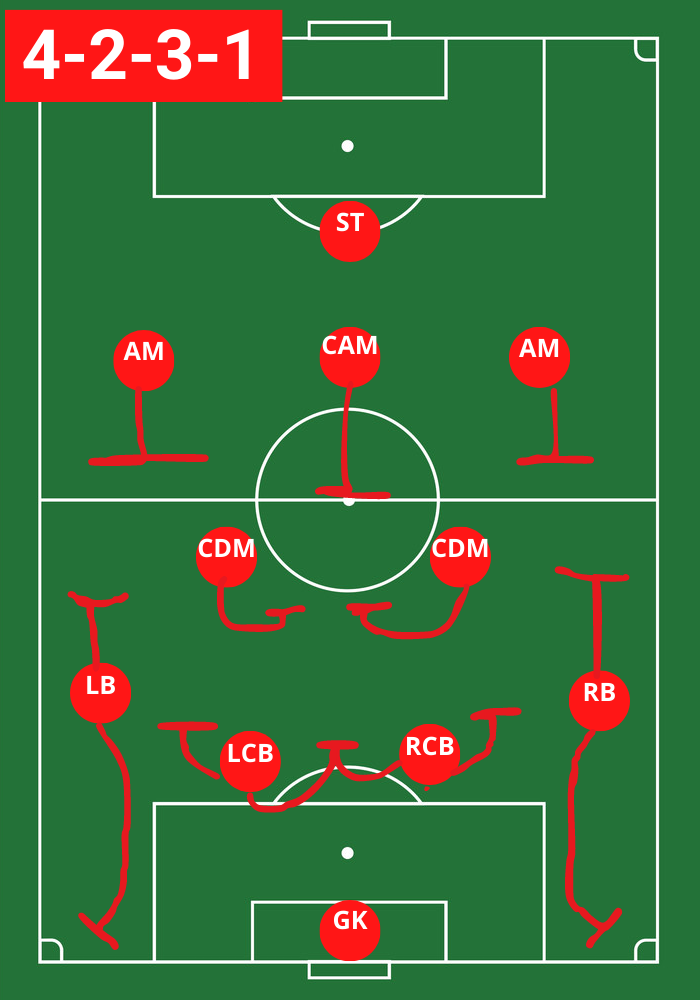- Last Updated -
Dominate the Field With The 4-2-3-1 Soccer Formation
Soccer is a dynamic game that constantly evolves, and its tactics are in a perpetual state of change. One widely employed formation across the globe is the 4-2-3-1, which comprises four defenders, two defensive midfielders, three attacking midfielders, and one striker.
The 4-2-3-1 soccer formation has garnered increasing popularity in contemporary soccer due to its adaptability and equilibrium in both offensive and defensive aspects. Coaches who grasp the strengths and weaknesses of this formation can mold their teams’ playing style accordingly.
The 4-2-3-1 formation offers a potent combination of defensive stability, midfield dominance, and attacking options. Nevertheless, it does possess certain limitations that opposing teams can exploit.
This article aims to provide an extensive analysis of the 4-2-3-1 soccer formation, encompassing its historical background, strengths, weaknesses, and tactical variations. By the conclusion of this piece, readers will possess a firm comprehension of how this formation operates in both offensive and defensive scenarios.

Brief Overview of The 4-2-3-1 Soccer Formation
The 4-2-3-1 soccer formation presents a modern adaptation of the well-established 4-4-2 system that has been utilized by numerous teams over the years.
This tactical arrangement incorporates four defenders, consisting of two center-backs and two fullbacks, along with two defensive midfielders, three attacking midfielders, and one lone striker positioned up front. The versatility of this formation empowers coaches to adapt their team’s strategy based on the playing style of their opponents, whether they opt to defend deep or apply high-pressure tactics on the field.
The two holding midfielders play a vital role in providing solid defensive coverage against counterattacks, while also granting the attacking players the freedom to venture forward without compromising the overall balance of the team.
This setup allows the attackers ample space to exhibit their skills, aided by the support of advanced fullbacks who can venture forward and overlap on either side of the pitch.

4-2-3-1 Formation Defense

4-2-3-1 Formation Attack
The Significance of Grasping the Strengths and Weaknesses of the 4-2-3-1 Formation
Comprehending the strengths and weaknesses of the 4-2-3-1 formation holds paramount importance for coaches at every level. While this formation boasts numerous advantages, it also harbors certain limitations that rival teams can exploit. Coaches must possess the ability to discern these shortcomings and adapt their strategies accordingly.
One of the notable strengths of this formation lies in its capacity to command possession and dictate the pace of the game. The two defensive midfielders furnish a sturdy foundation for attacking players to surge forward, while simultaneously providing a safety net against counterattacks.
Nevertheless, a significant drawback of this system manifests in its vulnerability on the flanks. Given that only two central midfielders are assigned the responsibility of covering wide areas, opposing teams can capitalize on the available space by executing overlapping runs from fullbacks or wingers.
Preview of Subtopics to be Covered
This article will cover various aspects related to the 4-2-3-1 soccer formation in detail. We will start by discussing its history before exploring its strengths and weaknesses in-depth.
We’ll then look at some tactical variations within this system before concluding. The history section will explore how this formation evolved over time and its impact on modern soccer tactics.
The strengths section will focus on how teams can use this system’s versatility to gain an advantage over their opponents while minimizing their defensive shortcomings. The weaknesses section will examine how opposition teams can exploit space in wide areas or target vulnerabilities created by an attack-heavy approach.
We’ll take a look at tactical variations such as high pressing or counterattacking within the 4-2-3-1 framework before concluding with some overall thoughts about the formation’s effectiveness in modern soccer tactics. Stay tuned for an insightful analysis that should help you understand why this soccer formation is so popular among managers across different leagues around the world! (2)
History of the 4-2-3-1 Formation
The Origin and Evolution of the Formation
The 4-2-3-1 formation was originally developed as a modification of the 4-4-2 formation. The aim was to provide more defensive cover while still allowing for attacking fluidity.
This was achieved by having two holding midfielders who would act as a shield for the defense, while still allowing for three attacking midfielders and a lone striker up front. The earliest known use of this formation dates back to the early 2000s in Brazil, where it was used by Corinthians under coach Carlos Alberto Parreira.
It proved to be successful, leading Corinthians to win both the Brazilian league title and Copa do Brasil in 2002. Since then, the formation has been adopted by many other teams around the world, with different variations depending on each coach’s tactical preferences.
Famous Teams and Coaches Who Have Used It Successfully
Many famous teams have used this formation successfully throughout history. One notable example is FC Barcelona under Pep Guardiola’s tenure from 2008 to 2012.
With this formation, Barcelona dominated European football, winning three La Liga titles and two Champions League titles during that period. Another famous team that has had success with this formation is Germany’s national team under Joachim Löw.
They used it effectively during their World Cup winning campaign in 2014. Other notable coaches who have utilized this formation include Jose Mourinho at Real Madrid and Chelsea, Carlo Ancelotti at AC Milan and Chelsea, and Arsene Wenger at Arsenal.
Impact on Modern Soccer Tactics
The adoption of the 4-2-3-1 formation has had a significant impact on modern soccer tactics. Many coaches now prefer using two holding midfielders instead of just one as it provides better defensive cover. This has resulted in a decrease in the use of the traditional 4-4-2 formation.
Additionally, the formation has allowed for greater attacking fluidity as teams can now have three attacking midfielders who can interchange positions and create more scoring opportunities. This has led to more creative play and an emphasis on individual skill.
Overall, the 4-2-3-1 formation has become a staple of modern soccer tactics, with many coaches utilizing it to great effect. Its impact on the game cannot be overlooked as it has revolutionized how teams approach both defensive and attacking play.
Strengths of the 4-2-3-1 Formation
Defensive Stability: The Importance of Two Holding Midfielders
One of the key strengths of the 4-2-3-1 formation is its ability to provide solid defensive stability through the use of two holding midfielders. These players typically sit in front of the defense and are responsible for breaking up opposition attacks and providing cover when defenders move out to intercept or tackle.
By having two holding midfielders, this formation can offer a strong barrier against opposing teams’ counterattacks.
Moreover, these holding midfielders can also serve as a link between defense and attack. They can pass the ball forward to attacking players, help build up attacks from deep positions, and support their attacking teammates when they’re involved in attacking moves.
Attacking Versatility: The Power of Three Attacking Midfielders
Another strength of this formation is its attacking versatility. With three attacking midfielders positioned just behind a single striker, teams can create multiple scoring opportunities with ease. These attacking midfielders are often given freedom to roam around the pitch and switch positions with each other during matches.
This allows them to create confusion among opposing defenders who may lose track of their markers during fast-paced attacks. The three attacking midfielders also provide different types of threats, with one being a more classic playmaker while another may be a goal scorer or dribbler that can create chances out nowhere.
Possession Control: Dictating Tempo Through Midfield Dominance
With two holding midfielders providing defensive cover combined with three creative attacking midfielders, the 4-2-3-1 offers great control over possession and tempo throughout games. Teams that use this formation are able to dominate games by controlling possession for long periods at a time without conceding many goals on counterattacks.
The combination of midfield dominance and the attacking versatility of this formation can also lead to effective ball retention, allowing teams to patiently build up their attacks until a clear-cut chance arises.
Adaptable Formation: Flexibility to Change Tactics
Another great strength of the 4-2-3-1 formation is its adaptability. Since this formation offers a good balance between defense and attack, teams can easily switch between offensive and defensive tactics based on their current needs.
For example, if a team wants to hold onto a lead in the later stages of a match, they can move one of their attacking midfielders back into central midfield and play with two holding midfielders instead. This gives them more defensive cover while still allowing them to keep possession and control the tempo from deep positions.
In Summary,
The 4-2-3-1 formation has become one of the most popular formations in modern soccer due to its defensive stability, attacking versatility, possession control ability and adaptability to change tactics as needed. With its balance between defense and attack, this formation allows teams to dominate games by controlling possession for long periods at a time without conceding many goals on counterattacks.
Weaknesses of the 4-2-3-1 Formation
Vulnerability to counterattacks due to lack of defensive cover in wide areas
One of the biggest weaknesses of the 4-2-3-1 formation is its susceptibility to counterattacks down the flanks. With only two central midfielders providing cover for the back four, it can be difficult to defend against quick breaks that exploit space out wide. Fullbacks are often tasked with providing width in attack and may find themselves caught out of position when the opposition launches a counterattack.
To combat this weakness, some teams have resorted to playing wingbacks who can both attack and defend effectively. This allows the fullbacks to stay back and help out with defensive duties, while also providing additional attacking options down the flanks.
Over-reliance on individual brilliance from attacking players
Another issue that teams using a 4-2-3-1 formation may face is becoming too reliant on their attacking players to create chances and score goals. With only one central striker supported by three attacking midfielders, there can be a lot of pressure on those players to produce moments of magic.
If those creative players are marked out of the game or having an off day, it can be difficult for a team playing in this system to generate chances and break down stubborn defences. It’s important for coaches using this formation to encourage all their players to contribute offensively and not rely solely on their top attackers.
Difficulty in transitioning from defense to attack quickly
The 4-2-3-1 formation also has its weaknesses when it comes to transitioning between defense and attack. The two midfield pivots are tasked with shielding the defence but often struggle when attempting quick transitions into attacking play.
It’s not uncommon for them to lose possession or make mistakes when trying to play the ball forward quickly, which can leave the team exposed in defence. To combat this issue, some coaches have experimented with playing more dynamic midfielders who are comfortable on the ball and can move it forward more efficiently.
The need for a technically gifted central attacking midfielder
Another weakness of the 4-2-3-1 formation is the need for a highly skilled central attacking midfielder. This player is tasked with linking up with both the attackers and midfielders, creating chances and scoring goals.
Without a technically gifted player in this position, it can be difficult for teams to create enough chances to win games. However, these players are often hard to come by and may require significant investment in terms of transfer fees or wages.
Tendency towards defensive play
With two holding midfielders providing defensive cover, teams using a 4-2-3-1 formation can sometimes fall into a defensive mindset. This can result in them sitting back and inviting pressure from their opponents rather than taking risks and playing attacking football.
To avoid this tendency towards overly cautious play, coaches may opt for more attack-minded players in their midfield or encourage their fullbacks to push up higher up the pitch. This allows them to keep possession better and put pressure on opposition defenses without sacrificing defensive stability altogether. (1)

Tactics within the 4-2-3-1 Formation
Role and responsibilities for each position (goalkeeper, defenders, midfielders, forwards)
The 4-2-3-1 formation has a very specific set of roles and responsibilities for each player on the field. The goalkeeper’s role is to provide a solid foundation for the team by making saves and organizing the defense. The four defenders are tasked with protecting the goal and shutting down opposing attacks.
They must communicate well with each other to ensure that there are no gaps in their coverage. The two central midfielders have an important job in helping to build up play from the back, linking defense to attack.
They need to be able to read the game and make quick decisions about when to pass, dribble or shoot. Meanwhile, the three attacking midfielders must be creative and dynamic, capable of unlocking defenses with their skillful dribbling and precise passing.
There is the central striker whose main responsibility is scoring goals. He/she must have good positioning skills within the box in order to receive passes from teammates who create space for them.
How different teams use this formation in different ways (e.g., high press, counterattack)
Teams use different tactics within this formation depending on their playing style and strengths. One common tactic is a high press where all players move up as soon as they lose possession in order to regain possession quickly before opponents can get organized. Some teams prefer a more defensive approach where they sit back and wait for counterattacks by using fast wing play or through balls from midfielders.
Others focus on creating chances through patient buildup play while maintaining careful defensive cover. In international soccer tournaments where matches may go into extra time or penalty shootouts if drawn after regulation time has ended – some teams may switch away from this system entirely by adopting more attacking formations such as a 3-4-3 or 4-3-3 in order to increase offensive pressure and secure more goals.
Conclusion
The 4-2-3-1 formation has been used successfully by many teams around the world for decades. It provides a good balance between attacking and defensive play, making it an effective option for teams with skilled midfielders and versatile forwards.
However, like any system, it is not without its weaknesses – most notably the vulnerability to counterattacks due to the lack of defensive cover in wide areas. Nevertheless, many top-level coaches continue to use this formation with great success and it remains a popular choice among players and fans alike.
Overall, the 4-2-3-1 formation offers a versatile framework within which skilled players can thrive. Whether you are watching soccer at home or playing on the field yourself, take note of how different teams use this system in different ways and think about how you might be able to incorporate some of these tactics into your own game.
FAQs - 4-2-3-1 soccer formation
What is the 4-2-3-1 Soccer Formation?
- The 4-2-3-1 formation is a popular soccer setup comprising four defenders, two defensive midfielders, three attacking midfielders, and one striker, known for its adaptability and balance in offensive and defensive play.
How does the 4-2-3-1 Formation differ from the traditional 4-4-2 system?
- It’s a modern adaptation of the 4-4-2 system, offering more defensive cover while maintaining attacking fluidity, with two holding midfielders providing solid defensive coverage and allowing freedom for attackers.
What are the strengths of the 4-2-3-1 Formation?
- Its strengths include defensive stability through two holding midfielders, attacking versatility with three attacking midfielders, control over possession and game tempo, and adaptability to change tactics based on game needs.
What are the weaknesses of the 4-2-3-1 Formation?
- The formation is vulnerable to counterattacks, especially in wide areas, can over-rely on individual brilliance from attackers, may struggle in quick transitions from defense to attack, and requires a skilled central attacking midfielder.
How has the 4-2-3-1 Formation evolved over time?
- Developed from the 4-4-2 formation, it gained prominence in the early 2000s in Brazil and has since been adopted globally, significantly impacting modern soccer tactics with its emphasis on defensive cover and attacking fluidity.
In what ways do teams employ tactical variations within the 4-2-3-1 Formation?
- Teams implement various tactics like high press, counterattack, or patient buildup play, adapting the formation based on playing style, match situation, and opponents’ strategies.
Why is the 4-2-3-1 Formation popular among coaches and players?
- Its effectiveness in balancing attack and defense, along with the versatility it offers to skilled players, makes it a popular choice in modern soccer, adopted by top-level coaches and teams worldwide.



















